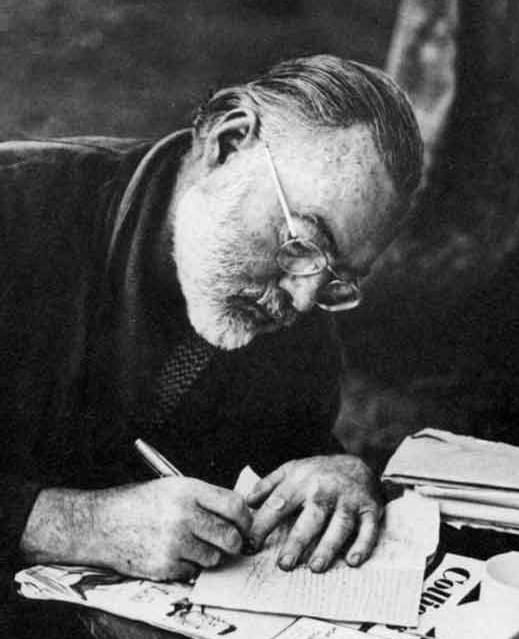Ernest Hemingway wasn't just a writer; he was a force of nature, a carefully constructed persona, and a literary titan whose lean, stripped-down prose reshaped 20th-century literature. Born in 1899, dead by his own hand in 1961, Hemingway lived a life that often mirrored the intense, sometimes brutal, themes of his work. He wasn't just typing stories; he was boxing, fishing, bullfighting, hunting, reporting from wars, surviving plane crashes, and cultivating an image of rugged, stoic masculinity that became as famous as his fiction. To understand Hemingway is to grapple with the intertwined realities of the adventurous life he led and the deceptively simple prose he wielded.
"The world breaks everyone, and afterward, some are strong at the broken places."–Ernest Hemingway
Hemingway crafted not only enduring novels and short stories but also the legend of "Papa" Hemingway – the hard-drinking, bull-fighting, deep-sea fishing, war-savvy expatriate. His early experiences profoundly influenced his worldview and writing. Serving as an ambulance driver in World War I, he was severely wounded, an event that brought him face-to-face with the physical and psychological trauma of conflict and the fragility of life.
He chased adventure, covering the Spanish Civil War, living in Cuba for decades, going on safaris in Africa. These experiences weren't just fodder for stories; they were the crucible in which his distinct literary voice was forged, focusing on characters grappling with disillusionment, courage, love, and death in a chaotic world.
"There is nothing to writing. All you do is sit down at a typewriter and bleed."–Hemingway
Perhaps the most defining characteristic of Hemingway's work is his famous laconic style. It's often described as minimalist or the "iceberg theory." Hemingway believed that the true power of a story lay not in what the author explicitly stated, but in what was omitted, the deeper meaning lurking beneath the surface, like the bulk of an iceberg hidden underwater. His prose is characterized by:
- Short, declarative sentences: He favored directness over complex clauses.
- Simple vocabulary: He avoided ornate or obscure words.
- Descriptions: He focused on observable actions, sensory details, and factual reporting, leaving emotional interpretation largely to the reader.
- Emphasis on dialogue: His characters' speech often carries significant weight, revealing more through how they talk and what they don't say than lengthy internal monologues.
Consider the opening lines of A Farewell to Arms:
In the late summer of that year we lived in a house in a village that looked across the river and the plain to the mountains. In the bed of the river there were pebbles and boulders, dry and white in the sun, and the water was clear and swiftly moving and blue in the channels. Troops went by the house and down the road and the dust they raised settled on the leaves of the trees.
Notice the simple sentence structure, the concrete nouns (house, village, river, mountains, pebbles, boulders, sun, water, channels, troops, road, dust, leaves, trees), and the focus on visual reality. There's no explicit mention of fear, tension, or the emotional weight of war yet, but the image of soldiers marching and dust settling carries an implicit sense of disruption and unsettledness.
Or take this exchange from The Sun Also Rises, showcasing the clipped, understated dialogue:
"Oh, Jake," Brett said, "we could have had such a damned good time together." Ahead was a mounted policeman in khaki directing traffic. "Yes," I said. "Isn't it pretty to think so?"
The emotional core of their relationship's impossibility is delivered not through elaborate declarations but through Brett's simple, poignant statement and Jake's famously understated, almost bitter, reply. The policeman detail is characteristic Hemingway – an observed, seemingly irrelevant detail that grounds the emotional moment in physical reality.
This "show, don't tell" approach was revolutionary, and many writers (myself inncluded) spend our lifetimes trying to exact anything close to perfection. It demanded more active participation from the reader and stood in stark contrast to the more verbose styles prevalent at the time. As Hemingway himself is often quoted (though the exact phrasing varies slightly), his aim was to "Write the truest sentence that you know." His style was a relentless pursuit of perceived truth through unadorned language.
"The best way to find out if you can trust somebody is to trust them."–Hemingway
Hemingway won the Pulitzer Prize for Fiction in 1953 for The Old Man and the Sea and the Nobel Prize in Literature in 1954. His style influenced generations of writers. While his public persona sometimes overshadowed his literary achievements and his style has been parodied, the best of his work remains timeless for its emotional depth, its unflinching look at difficult truths, and the sheer power he wrung from simple words.
"Never go on trips with anyone you do not love."–Hemingway
So, who the hell was Hemingway? He was a complex, flawed man who lived dramatically and wrote with an almost brutal economy. He was a craftsman who believed in the power of the unsaid. He was the adventurous hunter and fisherman who also exposed the vulnerabilities of the human heart. He was, undeniably, one of the most influential American writers of the 20th century, forever synonymous with a style that cut through excess to reveal the stark, compelling core of the story.

For my articles in this series, visit or bookmark the following;

Brent Antonson: Where Extraordinary Recall Sparks Insight.







